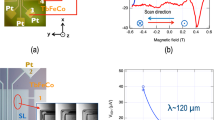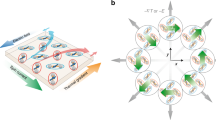Abstract
There has been an intense search in recent years for long-lived spin-polarized carriers for spintronic and quantum-computing devices. Here we report that spin-polarized quasiparticles in superconducting aluminium layers have surprisingly long spin lifetimes, nearly a million times longer than in their normal state. The lifetime is determined from the suppression of the aluminium’s superconductivity resulting from the accumulation of spin-polarized carriers in the aluminium layer using tunnel spin injectors. A Hanle effect, observed in the presence of small in-plane orthogonal fields, is shown to be quantitatively consistent with the presence of long-lived spin-polarized quasiparticles. Our experiments show that the superconducting state can be significantly modified by small electric currents, much smaller than the critical current, which is potentially useful for devices involving superconducting qubits.
This is a preview of subscription content, access via your institution
Access options
Subscribe to this journal
Receive 12 print issues and online access
$259.00 per year
only $21.58 per issue
Buy this article
- Purchase on Springer Link
- Instant access to full article PDF
Prices may be subject to local taxes which are calculated during checkout





Similar content being viewed by others
References
Buzdin, A. I. Proximity effects in superconductor–ferromagnet heterostructures. Rev. Mod. Phys. 77, 935–976 (2005).
Izyumov, Y. A., Proshin, Y. N. & Khusainov, M. G. Competition between superconductivity and magnetism in ferromagnet/superconductor heterostructures. Phys.-Usp. 45, 109–148 (2002).
Chien, C. L. & Reich, D. H. Proximity effects in superconducting/magnetic multilayers. J. Magn. Magn. Mater. 200, 83–94 (1999).
Jiang, J. S., Davidovic, D., Reich, D. H. & Chien, C. L. Oscillatory superconducting transition temperature in Nb/Gd multilayers. Phys. Rev. Lett. 74, 314–317 (1995).
Deutscher, G. & Meunier, F. Coupling between ferromagnetic layers through a superconductor. Phys. Rev. Lett. 22, 395–396 (1969).
Gu, J. Y. et al. Magnetization-orientation dependence of the superconducting transition temperature in the ferromagnet–superconductor–ferromagnet system: CuNi/Nb/CuNi. Phys. Rev. Lett. 89, 267001 (2002).
Moraru, I. C., Pratt, W. P. Jr & Birge, N. O. Magnetization-dependent Tc shift in ferromagnet/superconductor/ferromagnet trilayers with a strong ferromagnet. Phys. Rev. Lett. 96, 037004 (2006).
Pena, V. et al. Spin diffusion versus proximity effect at ferromagnet/superconductor La0.7Ca0.3MnO3/YBa2Cu3O7–δ interfaces. Phys. Rev. B 73, 104513 (2006).
Vas’ko, V. A. et al. Critical current suppression in a superconductor by injection of spin-polarized carriers from a ferromagnet. Phys. Rev. Lett. 78, 1134–1137 (1997).
Dong, Z. W. et al. Spin-polarized quasiparticle injection devices using Au/YBa2Cu3O7/LaAlO3/Nd0.7Sr0.3MnO3 heterostructures. Appl. Phys. Lett. 71, 1718–1720 (1997).
Yeh, N. C. et al. Nonequilibrium superconductivity under spin-polarized quasiparticle currents in perovskite ferromagnet–insulator–superconductor heterostructures. Phys. Rev. B 60, 10522–10526 (1999).
Takahashi, S., Imamura, H. & Maekawa, S. Spin imbalance and magnetoresistance in ferromagnet/superconductor/ferromagnet double tunnel junctions. Phys. Rev. Lett. 82, 3911–3914 (1999).
Parkin, S. S. P. et al. Giant tunneling magnetoresistance at room temperature with MgO(100) tunnel barriers. Nature Mater. 3, 862–867 (2004).
Yuasa, S., Nagahama, T., Fukushima, A., Suzuki, Y. & Ando, K. Giant room-temperature magnetoresistance in single-crystal Fe/MgO/Fe magnetic tunnel junctions. Nature Mater. 3, 868–871 (2004).
Johnson, M. & Silsbee, R. H. Interfacial charge-spin coupling: Injection and detection of spin magnetization in metals. Phys. Rev. Lett. 55, 1790–1793 (1985).
Johnson, M. & Silsbee, R. H. Spin-injection experiment. Phys. Rev. B 37, 5326–5335 (1988).
Jedema, F. J., Heersche, H. B., Filip, A. T., Baselmans, J. J. A. & van Wees, B. J. Electrical detection of spin precession in a metallic mesoscopic spin valve. Nature 416, 713–716 (2002).
Zaffalon, M. & van Wees, B. J. Zero-dimensional spin accumulation and spin dynamics in a mesoscopic metal island. Phys. Rev. Lett. 91, 186601 (2003).
Shin, Y-S., Lee, H-J. & Lee, H-W. Spin relaxation in mesoscopic superconducting Al wires. Phys. Rev. B 71, 144513 (2005).
Chen, C. D., Kuo, W., Chung, D. S., Shyu, J. H. & Wu, C. S. Evidence for suppression of superconductivity by spin imbalance in Co–Al–Co single-electron transistors. Phys. Rev. Lett. 88, 047004 (2002).
Johansson, J., Korenivski, V., Haviland, D. B. & Brataas, A. Giant fluctuations of superconducting order parameter in ferromagnet–superconductor single-electron transistors. Phys. Rev. Lett. 93, 216805 (2004).
Kivelson, S. A. & Rokhsar, D. S. Bogoliubov quasiparticles, spinons, and spin-charge decoupling in superconductors. Phys. Rev. B 41, 11693–11696 (1990).
Takahashi, S. & Maekawa, S. Hall effect induced by a spin-polarized current in superconductors. Phys. Rev. Lett. 88, 116601 (2002).
Leridon, B., Lesueur, J. & Aprili, M. Spin-bottleneck due to spin-charge separation in a superconductor. Phys. Rev. B 72, 180505R (2005).
Johansson, J., Urech, M., Haviland, D. & Korenivski, V. Suppression of superconductivity due to spin imbalance in Co/Al/Co single electron transistor. J. Appl. Phys. 93, 8650–8652 (2003).
Johansson, J., Urech, M., Haviland, D. & Korenivski, V. Comment on ‘Evidence for suppression of superconductivity by spin imbalance in Co–Al–Co single-electron transistors’. Phys. Rev. Lett. 91, 149701 (2003).
Poli, N. et al. Spin injection and relaxation in a mesoscopic superconductor. Phys. Rev. Lett. 100, 136601 (2008).
Yang, H., Yang, S-H., Parkin, S. S. P., Leo, T. & Smith, D. J. Optimized thickness of superconducting aluminum electrodes for measurement of spin polarization with MgO tunnel barriers. Appl. Phys. Lett. 90, 202502 (2007).
Tserkovnyak, Y. & Brataas, A. Current and spin torque in double tunnel barrier ferromagnet–superconductor–ferromagnet systems. Phys. Rev. B 65, 094517 (2002).
Parkin, S. S. P. et al. Magnetically engineered spintronic sensors and memory. Proc. IEEE 91, 661–680 (2003).
Takahashi, S., Yamashita, T., Imamura, H. & Maekawa, S. Spin-relaxation and magnetoresistance in FM/SC/FM tunnel junctions. J. Magn. Magn. Mater. 240, 100–102 (2002).
Fabian, J. & Das Sarma, S. Phonon-induced spin relaxation of conduction electrons in aluminum. Phys. Rev. Lett. 83, 1211–1214 (1999).
Zutic, I., Fabian, J. & Das Sarma, S. Spintronics: Fundamentals and applications. Rev. Mod. Phys. 76, 323–410 (2004).
Anderson, P. W. Knight shift in superconductors. Phys. Rev. Lett. 3, 325–326 (1959).
Yosida, K. Paramagnetic susceptibility in superconductors. Phys. Rev. 110, 769–770 (1958).
Anderson, P. W. Theory of dirty superconductors. J. Phys. Chem. Solids 11, 26–30 (1959).
Ferrell, R. A. Knight shift in superconductors. Phys. Rev. Lett. 3, 262–265 (1959).
Tombros, N., Jozsa, C., Popinciuc, M., Jonkman, H. T. & Wees, B. J. v. Electronic spin transport and spin precession in single graphene layers at room temperature. Nature 448, 571–574 (2007).
Appelbaum, I., Huang, B. Q. & Monsma, D. J. Electronic measurement and control of spin transport in silicon. Nature 447, 295–298 (2007).
Li, J., Huang, B. Q. & Appelbaum, I. Oblique Hanle effect in semiconductor spin transport devices. Appl. Phys. Lett. 92, 142507 (2008).
Gershoni, D. Long live the spin. Nature Mater. 5, 255–256 (2006).
Valenzuela, S. O. & Tinkham, M. Direct electronic measurement of the spin Hall effect. Nature 442, 176–179 (2006).
Jedema, F. J., Nijboer, M. S., Filip, A. T. & van Wees, B. J. Spin injection and spin accumulation in all-metal mesoscopic spin valves. Phys. Rev. B 67, 085319 (2003).
Acknowledgements
We would like to thank B. J. van Wees for useful discussions. This work is partially supported by DMEA, CREST-JST, Grant-in-Aid for Scientific Research from MEXT and the Next Generation Supercomputer Project, Nanoscience program, MEXT, Japan.
Author information
Authors and Affiliations
Contributions
H.Y. and S.S.P.P. initiated this work. H.Y. carried out the electrical transport experiments. S-H.Y. grew the samples, and carried out the Hanle effect experiment and the numerical calculations. S.T. and S.M. developed the theoretical models. S.S.P.P. supervised and led this research project. All authors wrote, edited the paper and discussed the data and the results.
Corresponding author
Ethics declarations
Competing interests
The authors declare no competing financial interests.
Supplementary information
Supplementary Information
Supplementary Information (PDF 1258 kb)
Rights and permissions
About this article
Cite this article
Yang, H., Yang, SH., Takahashi, S. et al. Extremely long quasiparticle spin lifetimes in superconducting aluminium using MgO tunnel spin injectors. Nature Mater 9, 586–593 (2010). https://doi.org/10.1038/nmat2781
Received:
Accepted:
Published:
Issue Date:
DOI: https://doi.org/10.1038/nmat2781
This article is cited by
-
Rashba-like physics in condensed matter
Nature Reviews Physics (2022)
-
Spin current as a probe of quantum materials
Nature Materials (2020)
-
Phase-Slip Lines in Wide Superconducting Strips: Charge and Spin Relaxation Lengths
Journal of Superconductivity and Novel Magnetism (2019)
-
Enhanced spin pumping into superconductors provides evidence for superconducting pure spin currents
Nature Materials (2018)
-
Quantum materials for spin and charge conversion
npj Quantum Materials (2018)



